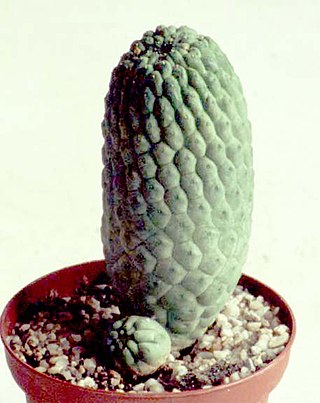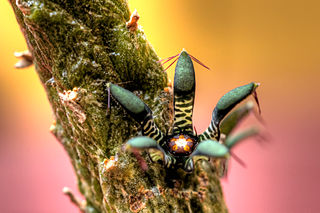
Hoodia is a genus of flowering plants in the family Apocynaceae, under the subfamily Asclepiadoideae, native to Southern Africa.

Stapeliinae is a subtribe of flowering plants within the tribe Ceropegieae of the subfamily Asclepiadoideae of the family Apocynaceae. The subtribe comprises about 35 genera, including both the stem-succulent "stapeliads" and the horticulturally popular genera Brachystelma and Ceropegia. The largest number of genera are native to Africa, but a more limited number of genera are widespread in Arabia and Asia. Historically, a similarly circumscribed taxon was treated as a separate tribe, Stapelieae.

The genus Huernia consists of perennial, stem succulents from Eastern and Southern Africa and Arabia, first described as a genus in 1810.

Gasteria is a genus of succulent plants, native to South Africa and the far south-west corner of Namibia.

Duvalia is a succulent plant genus in the subfamily Asclepiadoideae, in the family Apocynaceae (dogbane).

Larryleachia is a genus of stapeliad succulent flowering plants in the family Apocynaceae.

Lavrania is a monospecific genus of plants in family Apocynaceae. Its only species is Lavrania haagnerae, endemic to Namibia. Its natural habitat is rocky areas.

Stapelianthus is a genus of flowering plants in the family Apocynaceae, first described as a genus in 1933. The entire genus is endemic to Madagascar and is concentrated in the far south of the island.

Pseudolithos is a genus of succulent flowering plants of the family Apocynaceae, indigenous to arid areas of Somalia, Yemen and Oman.
Woodia is a genus in the family Apocynaceae first described as a genus in 1894. It is native to southern Africa
- Woodia mucronataN.E.Br.
- Woodia singularisN.E. Br.
- Woodia verruculosaSchltr.

Stapeliopsis is a genus of succulent plants in the family Apocynaceae, native to southern Africa.

Echidnopsis is a genus of succulent, cactus-like plants in the family Apocynaceae, first described as a genus in 1871. They are native to eastern Africa and the Arabian Peninsula.

Piaranthus is a succulent plant genus in the subfamily Asclepiadoideae, in the family Apocynaceae.
Eustegia is a genus of vines in the family Apocynaceae, first described as a genus with this name in 1810. It is native to southern Africa.
- Eustegia filiformis(L.f.) Schult.
- Eustegia fraternaN.E.Br.
- Eustegia hastata(Thunb.) R. Br. ex Schult.
- Eustegia macropetalaSchltr.
- Eustegia minuta(L.f.) N.E.Br.
- Eustegia plicataSchinz

Riocreuxia is a plant genus in the family Apocynaceae, and named in honour of the botanical illustrator Alfred Riocreux (1820-1912). It was first described as a genus in 1844 and is native to Africa.
Parapodium is a genus of flowering plants of the family Apocynaceae, first described as a genus in 1838. It is native to South Africa.
- Parapodium costatumE.Mey. - South Africa
- Parapodium crispumN.E.Br. - South Africa
- Parapodium simileN.E.Br. - South Africa
Pectinaria is a genus of plants in the family Apocynaceae, first described as a genus in 1819. The entire genus is endemic to South Africa.
Pentatropis is a genus of plants in the family Apocynaceae, first described as a genus in 1834. It is native to Africa and southern Asia.
Periglossum is a genus of flowering plants in the family Apocynaceae, first described as a genus in 1844. It is native to southern Africa.
- Periglossum angustifoliumDC. - South Africa
- Periglossum kassnerianumSchltr. - South Africa
- Periglossum mackeniiHarv. - South Africa
- Periglossum macrumDecne. - South Africa
- Periglossum mossambicenseSchltr. - Mozambique

Rhytidocaulon is a plant genus in the family Apocynaceae, first described in 1962. It is native to northeastern Africa and the Arabian Peninsula














